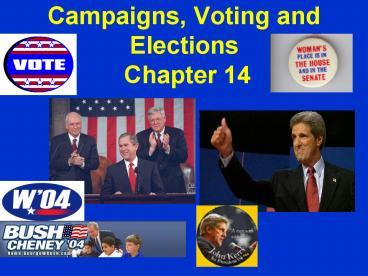Campaigns, Voting and Elections Chapter 14 PowerPoint PPT Presentation
1 / 36
Title: Campaigns, Voting and Elections Chapter 14
1
Campaigns, Voting and Elections Chapter 14
2
The Campaign Process At the Starting Block
- Personal Ambition leads Candidates to Run for
Office - Campaign Strategy aids them in Running
3
The Five Phases of a Political Campaign
Nomination Campaign To Win Party Nomination all
in same party
General Election Campaign Between different
political parties
4
The Five Phases of a Political Campaign
Personal Campaign give speeches hold press
conferences meet voters walk precincts
5
Organizational Campaign
Pollsters Campaign Managers
Fund-Raisers High technology
OFTEN Behind the Scenes
6
The MEDIA Campaign
PAID Media (TV/Radio) Free Media (Events that
get media coverage as news) Candidate Debates
7
Campaign Advertising
Positive Ads
Contrast Ads
Negative Ads
Spot Ads
Inoculation Ads
8
Success of Candidates Based On
- Abilities
- Qualifications
- Likability - Warmth
- Communication Skills
- Issues
- Weaknesses
9
SOURCES OF 1996 Senate Race CAMPAIGN Money (2
million)
- Individuals (60 1.2 Million)
- PACS ( 22 400,000)
- Parties (15 300,000)
- Candidate Money (3 60,000)
10
CAMPAIGN EXPENSES -- Where Does All that Money
GO????
11
CALIFORNIA Senate Race 2000Diane Feinstein (D)
vTom Campbell(R)
- Candidate Received Spent
- Feinstein 7,933,612 5,095,082
- Campbell 3,453,067 2,338,493
- Horn 522,536 523,035 (primary)
12
New York Senate Race 2000H. Clinton (D) v Rick
Lazio (R)
- Candidate Recvd Spent PACS
Individuals - H. Clinton 21,986,261 14,878,662 623,025
17,822,497 - R. Lazio 17,881,835 9,499,049 1,533,015
6,031,764
13
U.S. Presidential Election 2000G.W. Bush (R), Al
Gore (D)
- Candidate Recvd Spent PACS
Individual - G. W. Bush 177,124,836 121,482,508 881 97,154,857
- A. Gore 126,581,737 60,824,001 159 41,352,501
- R. Nader 3,571,575 3,253,565 390.
2,741,480 - P. Buchanan 15,736,546 16,211,976 2000.
7,114,905
14
The Purposes Served by Elections
- Legitimacy
- Accountability
- Retrospective Judgment
- Prospective Judgment
15
Kinds of Primary Elections
Open
Closed
Blanket
Run-off
16
Kinds of Elections
General Elections
Initiative
Referendum
Recall
17
Methods to Elect National Convention Delegates
- Winner-Take-All
- Proportional Representation
- Proportional Representation with Bonus Delegates
18
Methods to Elect National Convention Delegates
- Beauty Contest with Separate Delegate Selection
- Delegate Selection with No Beauty Contest
- The Caucus (Virginia uses)
19
Criticisms of Primaries
- Lack of quality information
- Front-loading
- Not a good test of skills to be president
- Very low voter turnout
20
The Party Conventions-Loss of Control by
State/Local Leaders
Delegate Selection
National Candidates and Issues
Media Coverage
21
The DelegatesDemocratic Republican
- Younger
- More diversity
- single/unmarried
- labor union
- Older
- White male
- Married
- Public service
22
Organizational Campaign
Pollsters Campaign Managers
Fund-Raisers High technology
OFTEN Behind the Scenes
23
The Electoral College
representatives (electors) from each state, equal
in number to the House and Senate members from
the state, who actually elect the President
and Vice-President
24
Electoral College-Framers Intent
- Part of original US Constitution
- To protect citizens from too much direct
democracy - Work without political parties
- Cover nominating and electing stages
- Produce a nonpartisan president
- Share the election process between state and
national levels of government
25
Who Chooses Electors
- Political Parties nominate electors at their
conventions, (538 total) - Include state elected officials, party loyalists,
party leaders, friends of presidential candidate - Chosen by VOTERS (although the electors names
not on ballots)
26
ELECTORAL College Process
- Designed by James Madison
- January 2005 Joint session U.S. Congress counts
Electoral Votes - ONLY Half of the states (and DC) require electors
to vote according to the popular vote totals - Each states gets number of ELECTORS equal to
their Congressional Representation
27
The ELECTORAL College2000 U.S. Presidential
Race(Oct 30, 2000 ABCNews.com)
28
How The popular vote Loser became U.S. President
- President NOT elected by national popular vote
- Elected by state-vote of electors
- 48 of 50 states (and DC) award electoral
votes on winner-takes-all - Has happened THREE TIMES (1876,1888, 2000)
29
What if Nobody gets 270 Electoral VOTES?
- IF a tie at 269
- GOES INTO THE U.S. House of Representatives
- EACH state gets one vote
30
Congressional Elections
- Incumbency Advantage 80-90 percent re-election
- WHY?
- Name recognition
- easier fund-raising
- franking privilege
31
Importance of 2000 Congressional/State
Legislature elections
- REAPPORTIONMENT --
- Redrawing legislative districts (by state
legislatures) for state and congressional races - based on population (from
2000 Census) - political advantage(s)
- racial? considerations
32
2004 Congressional Elections
- 1/3 of U.S. Senate
- Entire US House
- 11 U.S. Governors
33
Variables that Impact Voter Turnout
Income
Age
Interest in Politics
Race
34
Difficult Registration
Poor voter attitudes
Hard Absentee Voting
Weak political parties
Number of Elections
Low voter turnout
35
Improving Voter Turnout
- Easier Registration and Absentee Voting
- Make Election Day a Holiday
- Strengthen Parties
- Mail-In Ballots?
36
Changing the Electoral Process
- Mandatory Voting
- Eliminate Electoral College
- Regional Primaries
- Campaign Finance Reform
- Regulate SOFT Money and PACS

